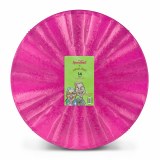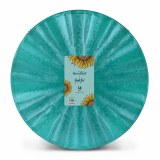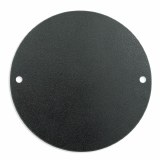Pottery wheel bats are flat discs that attach to a pottery wheel head and allow a thrown pot to be removed from the wheelhead without touching the pot itself. Bats are manufactured in a variety of sizes and shapes and can be made from range of different materials such as plastic, wood, and plaster. Pottery bats are typically fabricated with two holes that fit onto a pair of bat pins that are inserted into the wheel head. Bat pins are typically drilled at 10" on center, though some wheels due to age, size, or country of origin, may have different pin spacing. While circular bats are the traditional version of pottery wheel bats, square bats are beneficial because they take up less space on your ware shelf.
Pottery bats are a staple in almost every pottery studio and are invaluable to any potter. Because the bat (along with the pot that is thrown on it) can be easily removed from the potter’s wheel head, there is no need to directly handle the pot protecting the shape and form from disruption. Working on a bat also eliminates potential reactions between certain clay bodies and the pottery wheel head. Throwing with some porcelains and clays directly on an aluminum wheel head without a bat can result in pitting or oxidation, especially if the clay is left touching the head for any extended amount of time.
Bats come in a variety of materials which all each have advantages and disadvantages.
Plastic bats are durable and resistant to water damage allowing them to last a long time. While they are relatively inexpensive, the downside of plastic bats is that they do not release from clay easily, and lead to uneven drying between the rim and the bottom.
Masonite bats, also called tempered hardboard, are a wood fiber based material and are susceptible to warping and other damage from sustained water exposure. This susceptibility is also what allows these bats to release clay more readily than plastic, and as an affordable option, are a staple in studios everywhere.
Medex bats are made from a water-resistant version of MDF or medium density fiberboard. Like masonite bats, they are similarly susceptible to prolonged exposure to water and release well from clay.
Hydrobats are made from a reinforced, hard-setting plaster called Hydrostone. They are durable, though more fragile than a plastic or medex bats, and have excellent water corrosion resistance. Best of all, hydrobats have an unparalleled release from clay with no need for the use of a wire cutoff tool. Since they are made from plaster, Hydrobats absorb water without distortion or degradation, allowing wet clay to stick and releasing when it has dried out to leather hard. This feature is unmatched in other materials and will allow your pots to dry evenly from top to bottom.
FILTER
Brand
- Amaco (3)
- Chinese Clay Art (3)
- Giffin Grip (1)
- Kentucky Mudworks (8)
- New England Hardboard (19)
- North Star (2)
- Pottery Mill (15)
- Quark (1)
- Shimpo Nidec (1)
- Speedball (13)
- The Ceramic Shop (7)
- Xiem (4)


Item #: CCADGD60G
Chinese Clay Art
Diamond Grinding Disc with Bat
$87.00
$78.30
You Save: 10%





























